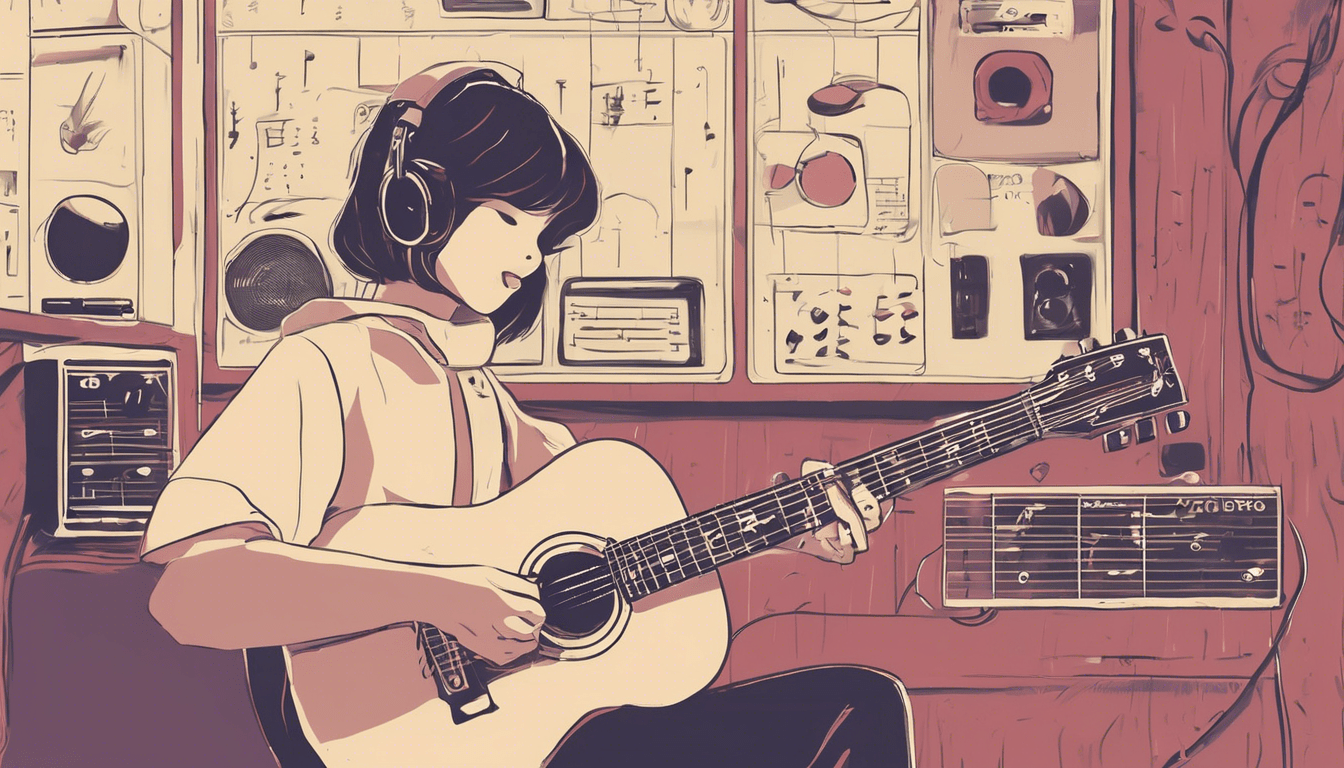Creating calming lofi guitar progressions goes beyond mere chords; it’s about evoking a serene mood through subtle voicings and rhythmic nuances. By exploring microtonal variations and thoughtful strumming, musicians can craft soundscapes that invite relaxation. Understanding these elements offers a deeper perspective on how to transform simple progressions into effective tools for mood setting, making your music not just mellow but truly immersive.
Understanding Lofi Guitar Chord Progressions
The heart of any lofi guitar progression lies in its ability to craft a calm, immersive atmosphere. These progressions are carefully chosen to evoke a sense of tranquility and ease, making them essential in creating lofi music that listeners find soothing. At their core, relaxing chord patterns often utilize smooth transitions and warm tonalities, avoiding harsh or overly bright sounds that might disrupt the mood.
In the same genre : 5 Tips to Upgrade Your Industrial Electrical Systems Efficiently
Common characteristics of lofi guitar chords include the use of extended harmonies—such as seventh, ninth, and suspended chords—that add lushness without complexity. These chords typically move slowly, allowing each sound to resonate fully, which encourages a state of relaxation. For example, progressions that incorporate minor seventh chords paired with gentle melodic movements create a wistful, calming effect that is signature to lofi guitar progressions.
By focusing on such calm music composition techniques, artists harness the power of soothing progressions to influence listeners’ moods positively. These progressions help in setting the right ambiance, whether it’s for studying, unwinding, or background music. The deliberate simplicity and organic feel of relaxing chord patterns ensure the music supports mental clarity rather than distraction.
Also to see : Data security: measures taken by the New Zealand eTA Assistant application
For musicians interested in deepening their understanding or creating their own calming atmospheres, starting with a straightforward lofi guitar progression that emphasizes smooth, mellow chords is a practical approach. This encourages an engaging yet unobtrusive sonic experience that is both accessible and emotionally resonant.
If you’re curious about specific examples to kickstart your journey, exploring a Lofi chord progression can offer practical insight into how these chords blend to create the distinct lofi sound.
Key Elements of Calm Lofi Guitar Progressions
Crafting lofi chords that evoke a sense of calm requires deliberate attention to both harmony and rhythm. The foundation of a chill musical mood lies in the choice of chords and the way they are played. Using musical mood as a guide, guitarists often select chords that inherently carry warmth and softness, such as seventh or suspended chords. These chords naturally promote a relaxed atmosphere, ideal for lofi tracks.
Integrating chill music chord tips, guitarists can experiment with adding subtle harmonic complexity through extended chords. For example, seventh and ninth chords introduce a gentle tension and resolution pattern that feels soothing rather than harsh. Moreover, incorporating microtonal shifts or delicate alterations to chord voicings—slight detuning or unique finger placements—can infuse progressions with a distinct warmth that resonates with listeners seeking tranquility.
Rhythm plays an equally crucial role in enhancing calmness. Gentle strumming or fingerpicking patterns that emphasize space and timing contribute significantly to the laid-back feel. Employing rhythmic pauses or syncopation creates breathing room within the progression, allowing each chord to linger and settle. This use of space, combined with precise timing, ensures the chill music chord tips foster a serene and immersive experience, inviting listeners to unwind with every note.
Exploring these elements can deepen one’s understanding of how lofi chords shape a musical mood. For those interested in practical application, a recommended resource is the article on Lofi chord progression, which offers insightful guidance on blending these techniques effectively.
Discovering Three Variations of Lofi Guitar Chord Progressions
Exploring chill guitar progressions is a key part of mastering lofi crafting. These progressions shape the overall feel and atmosphere of your relaxing music tutorials, helping you convey emotions with subtlety and warmth.
Each lofi guitar chord progression serves a distinct purpose. Understanding their structures allows you to tailor your sound, whether you aim to soothe, inspire, or evoke a sense of nostalgia. Let’s delve into three unique variations that stand out in lofi music creation, giving you practical tools and inspiration.
Discovering these chill guitar progressions enhances your ability to produce authentic, relaxing music tutorials that genuinely engage your audience. Integrating different tempos, dynamics, and voicings gives you the flexibility to personalize each progression, making your compositions truly your own.
For musicians eager to deepen their lofi crafting skills, learning how these chord sequences function—and how to manipulate them—forms the foundation of a compelling and evocative musical experience. Whether you’re producing for study beats or soulful backdrops, these progressions are excellent starting points that you can build upon creatively.
Practical Application and Modification Tips
When it comes to music production and LoFi composition, incorporating a well-crafted chord progression can significantly enhance your track’s mood and flow. Start by integrating these chord progressions into your compositions during the foundational writing phase. By using a progression as the backbone, you ensure harmonic coherence and set a calming atmosphere right from the start.
In terms of guitar practice, focus on playing these progressions with light, sustained strumming or gentle fingerpicking. Techniques such as muting strings delicately or applying subtle vibrato can heighten the calming effect. Experimenting with tempo and dynamics also allows you to tailor the emotional quality of your music—slower tempos tend to deepen relaxation, while slightly quicker rhythms might energize without losing the chill vibe.
Modifying progressions is an effective way to evoke different emotional responses or fit various genres. For instance, changing chord voicings—like swapping major chords for minor ones or adding seventh and ninth intervals—can introduce melancholy or jazzy textures suited for LoFi or ambient genres. Transposing progressions to different keys also adjusts the tonal color, helping you customize your composition to fit your desired mood.
By mastering these techniques and modifications, you can confidently infuse your guitar playing and music production with personalized LoFi chord progressions that resonate emotionally and elevate your creative output. For those eager to explore fresh ideas, consider experimenting with a Lofi chord progression.
Resources for Learning and Implementing
When diving into guitar tutorials focused on lofi music, a combination of visual and interactive materials enhances learning significantly. Many platforms now offer video lessons tailored to capturing the relaxed, mellow vibe characteristic of lofi styles. These lessons often walk you through essential chord progressions, demonstrating finger positioning and rhythm at a comfortable pace, making them ideal for beginners and intermediate players alike.
Chord chart guides serve as invaluable tools during practice sessions. Visual chord charts present a clear layout of fretboard finger placements, which helps learners memorize and play common lofi guitar chords efficiently. Having these guides readily available—for example, printed or on digital devices—allows quick reference without interrupting practice flow.
For effective practice and recording, consistency matters. Set aside focused time to work on transitioning smoothly between chords, especially those common in lofi music resources such as minor seventh or suspended chords that create that distinct ambient sound. Recording yourself can reveal subtle timing issues and inspire adjustments in dynamics, enriching your playing style and sound.
Additionally, exploring apps designed for guitarists can add an engaging interactive element, offering metronome functions, playback options, and even backing tracks. These features allow you to better integrate the subtle nuances of lofi chord progression into your own music.
For a practical deep dive into this style, consider trying out examples of Lofi chord progression to experience how these elements merge to create that calming, nostalgic mood. This hands-on approach, paired with expert tutorials and clear chord charts, bolsters your ability to master and personalize lofi guitar music.






